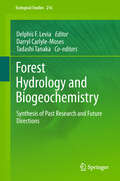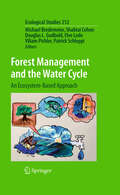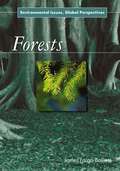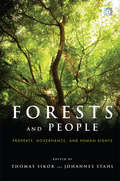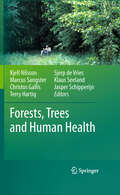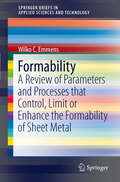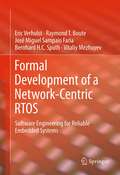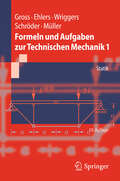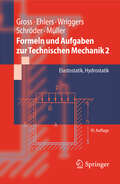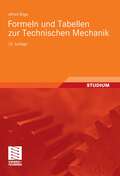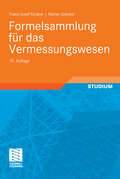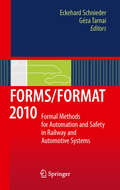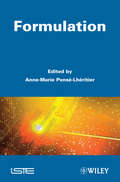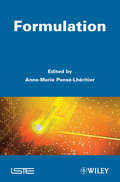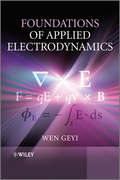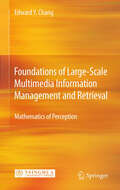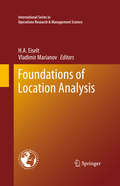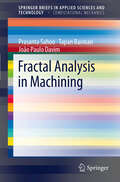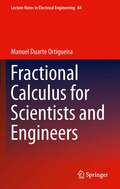- Table View
- List View
Forest Hydrology and Biogeochemistry: Synthesis of Past Research and Future Directions (Ecological Studies #216)
by Delphis F. Levia, Darryl Carlyle-Moses and Tadashi TanakaThis international rigorously peer-reviewed volume critically synthesizes current knowledge in forest hydrology and biogeochemistry. It is a one-stop comprehensive reference tool for researchers and practitioners in the fields of hydrology, biogeoscience, ecology, forestry, boundary-layer meteorology, and geography. Following an introductory chapter tracing the historical roots of the subject, the book is divided into the following main sections:· Sampling and Novel Approaches· Forest Hydrology and Biogeochemistry by Ecoregion and Forest Type· Hydrologic and Biogeochemical Fluxes from the Canopy to the Phreatic Surface· Hydrologic and Biogeochemical Fluxes in Forest Ecosystems: Effects of Time, Stressors, and HumansThe volume concludes with a final chapter that reflects on the current state of knowledge and identifies some areas in need of further research.
Forest Management and the Water Cycle: An Ecosystem-Based Approach (Ecological Studies #212)
by Michael Bredemeier, Shabtai Cohen, Douglas L. Godbold, Elve Lode, Viliam Pichler and Patrick SchleppiThe protective function of forests for water quality and water-related hazards, as well as adequate water supplies for forest ecosystems in Europe, are potentially at risk due to changing climate and changing land-management practices. Water budgets of forest ecosystems are heavily dependent on climate and forest structure. The latter is determined by the management measures applied in the forestry sector. Various developments of forest management strategies, imposed on a background of changing climate, are considered in assessing the overall future of forest–water interactions in Europe.Synthesizing recent research on the interactions of forest management and the water regime of forests in Europe and beyond, the book makes an important contribution to the ongoing dialogue between scientists dealing with different scales of forest-water interactions. This collaborative endeavour, which covers geographic and climatic gradients from Iceland to Israel and from southern Spain to Estonia and Finland, was made possible through the COST Action "Forest Management and the Water Cycle (FORMAN)", which was launched in 2007 (http://www.forestandwater.eu/). The book will be of particular interest to the research community involved in forest ecosystem research and forest hydrology, as well as landscape ecologists and hydrologists in general. It will also provide reference material for forest practitioners and planners in hydrology and land use.
Forests: Environmental Issues, Global Perspectives (Environmental Issues, Global Perspectives Ser.)
by James Fargo BalliettForests are considered the lungs of the planet, as they consume and store carbon dioxide and produce oxygen. These biomes, defined as ecological communities dominated by long-lived woody vegetation, historically have provided an economic foundation for growing nations, supplying wood for buildings, firewood for fuel, and land for expanding cities and farms. For centuries, industrial nations in Europe and the United States have relied on large tracts of forestland for economic prosperity. The research presented in this book reveals that population pressures are causing considerable environmental distress in even the most remote forest areas. Three detailed case studies are presented. The first provides an assessment of illegal logging deep in South America’s Amazon rain forest, a region closely tied to food and product demands thousands of miles away. The second examines the effect of increased hunting in Central Africa’s Congo forest, which threatens wildlife, especially mammal species with slower reproductive cycles. Finally the third describes encroachment on old-growth tropical forests on the Southern Pacific island of Borneo, which today is better managed thanks to the collective planning and conservation efforts of the governments of Brunei, Indonesia, and Malaysia.
Forests: Environmental Issues, Global Perspectives
by James Fargo BalliettForests are considered the lungs of the planet, as they consume and store carbon dioxide and produce oxygen. These biomes, defined as ecological communities dominated by long-lived woody vegetation, historically have provided an economic foundation for growing nations, supplying wood for buildings, firewood for fuel, and land for expanding cities and farms. For centuries, industrial nations in Europe and the United States have relied on large tracts of forestland for economic prosperity. The research presented in this book reveals that population pressures are causing considerable environmental distress in even the most remote forest areas. Three detailed case studies are presented. The first provides an assessment of illegal logging deep in South America’s Amazon rain forest, a region closely tied to food and product demands thousands of miles away. The second examines the effect of increased hunting in Central Africa’s Congo forest, which threatens wildlife, especially mammal species with slower reproductive cycles. Finally the third describes encroachment on old-growth tropical forests on the Southern Pacific island of Borneo, which today is better managed thanks to the collective planning and conservation efforts of the governments of Brunei, Indonesia, and Malaysia.
Forests and People: Property, Governance, and Human Rights
by Thomas Sikor Johannes StahlA human rights-based agenda has received significant attention in writings on general development policy, but less so in forestry. Forests and People presents a comprehensive analysis of the rights-based agenda in forestry, connecting it with existing work on tenure reform, governance rights and cultural rights. As the editors note in their introduction, the attention to rights in forestry differs from 'rights-based approaches' in international development and other natural resource fields in three critical ways. First, redistribution is a central demand of activists in forestry but not in other fields. Many forest rights activists call for not only the redirection of forest benefits but also the redistribution of forest tenure to redress historical inequalities. Second, the rights agenda in forestry emerges from numerous grassroots initiatives, setting forest-related human rights apart from approaches that derive legitimacy from transnational human rights norms and are driven by international and national organizations. Third, forest rights activists attend to individual as well as peoples' collective rights whereas approaches in other fields tend to emphasize one or the other set of rights. Forests and People is a timely response to the challenges that remain for advocates as new trends and initiatives, such as market-based governance, REDD, and a rush to biofuels, can sometimes seem at odds with the gains from what has been a two decade expansion of forest peoples' rights. It explores the implications of these forces, and generates new insights on forest governance for scholars and provides strategic guidance for activists.
Forests and People: Property, Governance, and Human Rights
by Thomas Sikor Johannes StahlA human rights-based agenda has received significant attention in writings on general development policy, but less so in forestry. Forests and People presents a comprehensive analysis of the rights-based agenda in forestry, connecting it with existing work on tenure reform, governance rights and cultural rights. As the editors note in their introduction, the attention to rights in forestry differs from 'rights-based approaches' in international development and other natural resource fields in three critical ways. First, redistribution is a central demand of activists in forestry but not in other fields. Many forest rights activists call for not only the redirection of forest benefits but also the redistribution of forest tenure to redress historical inequalities. Second, the rights agenda in forestry emerges from numerous grassroots initiatives, setting forest-related human rights apart from approaches that derive legitimacy from transnational human rights norms and are driven by international and national organizations. Third, forest rights activists attend to individual as well as peoples' collective rights whereas approaches in other fields tend to emphasize one or the other set of rights. Forests and People is a timely response to the challenges that remain for advocates as new trends and initiatives, such as market-based governance, REDD, and a rush to biofuels, can sometimes seem at odds with the gains from what has been a two decade expansion of forest peoples' rights. It explores the implications of these forces, and generates new insights on forest governance for scholars and provides strategic guidance for activists.
Forests, Trees and Human Health
by Kjell Nilsson, Marcus Sangster, Christos Gallis, Terry Hartig, Sjerp de Vries, Klaus Seeland and Jasper SchipperijnThe link between modern lifestyles and increasing levels of chronic heart disease, obesity, stress and poor mental health is a concern across the world. The cost of dealing with these conditions places a large burden on national public health budgets so that policymakers are increasingly looking at prevention as a cost-effective alternative to medical treatment. Attention is turning towards interactions between the environment and lifestyles. Exploring the relationships between health, natural environments in general, and forests in particular, this groundbreaking book is the outcome of the European Union’s COST Action E39 ‘Forests, Trees and Human Health and Wellbeing’, and draws together work carried out over four years by scientists from 25 countries working in the fields of forestry, health, environment and social sciences. While the focus is primarily on health priorities defined within Europe, this volume explicitly draws also on research from North America.
Formability: A Review of Parameters and Processes that Control, Limit or Enhance the Formability of Sheet Metal (SpringerBriefs in Applied Sciences and Technology)
by Wilko C. Emmens- Overview of materials and treatment aspects of manufacturability of sheet metal - Written by an industrial expert turned scientist - Concentrates on the formability of sheet metal, one of the fundamental form material is used in metalworking
Formal Development of a Network-Centric RTOS: Software Engineering for Reliable Embedded Systems
by Eric Verhulst Raymond T. Boute José Miguel Faria Bernhard H.C. Sputh Vitaliy MezhuyevMany systems, devices and appliances used routinely in everyday life, ranging from cell phones to cars, contain significant amounts of software that is not directly visible to the user and is therefore called "embedded". For coordinating the various software components and allowing them to communicate with each other, support software is needed, called an operating system (OS). Because embedded software must function in real time (RT), a RTOS is needed. This book describes a formally developed, network-centric Real-Time Operating System, OpenComRTOS. One of the first in its kind, OpenComRTOS was originally developed to verify the usefulness of formal methods in the context of embedded software engineering. Using the formal methods described in this book produces results that are more reliable while delivering higher performance. The result is a unique real-time concurrent programming system that supports heterogeneous systems with just 5 Kbytes/node. It is compatible with safety related engineering standards, such as IEC61508.
Formeln und Aufgaben zur Technischen Mechanik 1: Statik (Springer-Lehrbuch)
by Dietmar Gross Wolfgang Ehlers Peter Wriggers Jörg Schröder Ralf MüllerDie Aufgabensammlung zum Band „Technische Mechanik 1 (Statik)“ enthält die wichtigsten Formeln und mehr als 140 didaktisch gut aufgebaute, vollständig gelöste Aufgaben. Besonderer Wert wird auf das Finden des Lösungswegs und das Erstellen der Grundgleichungen gelegt. Folgende Themen werden in den Aufgaben behandelt: Gleichgewicht; Schwerpunkt; Lagerreaktionen; Fachwerke; Balken, Rahmen, Bogen; Seile; Arbeitsbegriff in der Statik; Haftung und Reibung; Flächenträgheitsmomente. Die 10. Auflage präsentiert sich in einem neuen, zweifarbigen Layout.
Formeln und Aufgaben zur Technischen Mechanik 2: Elastostatik, Hydrostatik (Springer-Lehrbuch)
by Dietmar Gross Wolfgang Ehlers Peter Wriggers Jörg Schröder Ralf MüllerDas Aufgabenbuch zur Technischen Mechanik 2 (Elastostatik, Hydrostatik) enthält die wichtigsten Formeln und etwa 150 vollständig gelöste Aufgaben. Weil der Weg zum erfolgreichen Studium der Technischen Mechanik über das selbständige Lösen von Aufgaben führt, legen die Autoren besonderen Wert darauf, dass Leser befähigt werden Lösungswege zu finden und Grundgleichungen zu erstellen. In dem Band werden folgende Themen behandelt: Spannung und Verzerrung, Zug und Druck, Biegung, Torsion, der Arbeitsbegriff in der Elastostatik, Stabilität, Hydrostatik.
Formeln und Tabellen zur Technischen Mechanik
by Alfred BögeIm Lehr- und Lernsystem Technische Mechanik unterstützt die Formelsammlung das selbstständige Lernen bei der Hausarbeit genauso wie bei der Lösung von Klausuraufgaben. Die Formeln und Tabellen liefern die physikalischen, mathematischen und technischen Daten zum Lösen der Aufgaben. Die aktuelle Auflage wurde an die 29. Auflage des Lehrbuchs angepasst.
Formelsammlung für das Vermessungswesen
by Franz Josef Gruber Rainer JoeckelDie kompakt und übersichtlich gestaltete Formelsammlung enthält alle wichtigen vermessungstechnischen und mathematischen Formeln. Der Aufbau des Buches mit über 200 Abbildungen garantiert ein schnelles und unkompliziertes Auffinden aller gesuchten Formeln. Ob zur Vorbereitung auf Klausuren oder zum späteren Nachschlagen in der Berufspraxis - die Sammlung ist immer eine sichere Hilfestellung. Das Buch ist in seiner Darstellung konkurrenzlos auf dem deutschen Buchmarkt. Die 15. Auflage wurde den aktuellen Entwicklungen angepasst.
FORMS/FORMAT 2010: Formal Methods for Automation and Safety in Railway and Automotive Systems
by Eckehard Schnieder Geza TarnaiComplexity in automation- and safety systems in railway as well as automotive applications are dominated more and more by formal description means, methods and tools. Formal techniques provide next to correctness and integrity checkups – especially for safety relevant systems – the possibility to model, prove, simulate and check the specification of the system as well as to generate the system implementations. Requirements of the CENELEC- and IEC-Standards on formal techniques, particularly with regard to the handling of safety analysis, are to be treated in FORMS/FORMAT 2010. The main focus lies on topics facing formal techniques for railway applications and intelligent transportation systems as well as for automotive applications. Gained findings, experiences and also difficulties associated with the handling of the subject matter as well as description means and tools are to be shown.
Formulation
by Anne-Marie Pensé-LhéritierThis book deals with the formulation of industrial products Its field of application goes from food-processing industry to the industry of elastomers showing that the principles of development follow always the same methodology.
Formulation
by Anne-Marie Pensé-LhéritierThis book deals with the formulation of industrial products Its field of application goes from food-processing industry to the industry of elastomers showing that the principles of development follow always the same methodology.
Fortified Foods with Vitamins: Analytical Concepts to Assure Better and Safer Products
by Michael RychlikUnique in its review of modern analytical approaches to vitamin fortification, this book emphasizes fast, sensitive, and accurate methods, along with assays enabling the detection of various isomers and multiple vitamins. The expert contributors describe the concepts as well as analytical and assay methods to study fortification, along with applications to create better and safer foods. Taking into considerations regulatory matters, they include data on sampling and extraction methods, and discuss the various pros and cons of each. As a result, readers are able to determine, which type of analytical method is best suited for added vitamins. A practical guide for food chemists and technologists, as well as analytical laboratories and biochemists.
Fortified Foods with Vitamins: Analytical Concepts to Assure Better and Safer Products
by Michael RychlikUnique in its review of modern analytical approaches to vitamin fortification, this book emphasizes fast, sensitive, and accurate methods, along with assays enabling the detection of various isomers and multiple vitamins. The expert contributors describe the concepts as well as analytical and assay methods to study fortification, along with applications to create better and safer foods. Taking into considerations regulatory matters, they include data on sampling and extraction methods, and discuss the various pros and cons of each. As a result, readers are able to determine, which type of analytical method is best suited for added vitamins. A practical guide for food chemists and technologists, as well as analytical laboratories and biochemists.
Foundations KS3: Resistant Materials Technology (PDF)
by Paul Anderson Jeff Draisey'Design and Technology Foundations' student books are matched to the KS3 assessment criteria and programme of study, with engaging content and activities to help develop the design skills and knowledge required at Key Stage 3 and beyond.
Foundations of Applied Electrodynamics
by Wen GeyiFoundations of Applied Electrodynamics takes a fresh look at the essential concepts and methods of electrodynamics as a whole, uniting the most relevant contemporary topics under a common mathematical framework. It contains clear explanations of high-level concepts as well as the mutual relationships between the essential ideas of electromagnetic theory. Starting with the fundamentals of electrodynamics, it methodically covers a wide spectrum of research and applications that stem from electromagnetic phenomena, before concluding with more advanced topics such as quantum mechanics. Includes new advances and methodologies in applied electrodynamics, and provides the whole picture of the theory of electrodynamics in most active areas of engineering applications Systematically deals with eigenvalue problems, integral equation formulations and transient phenomena in various areas of applied electrodynamics Introduces the complete theory of spherical vector wave functions, and presents the upper bounds of the product of gain and bandwidth for an arbitrary antenna Presents the field approach to multiple antenna system, which provides a theoretical tool for the prediction of channel models of MIMO, and is also the basis of wireless power transmission system One of the first books on electromagnetics that contains the general theory of relativity, which is needed in the design of mobile systems such as global positioning system (GPS) By summarising both engineering and theoretical electromagnetism in one volume, this book is an essential reference for practicing engineers, as well as a guide for those who wish to advance their analytical techniques for studying applied electrodynamics.
Foundations of Education: Problems and Possibilities in American Education
by Samuel M. Craver Maike Ingrid PhilipsenFoundations of Education is organized around the major problems facing contemporary American education. It offers a thorough, scholarly treatment of these problems from historical, philosophical, and sociological perspectives, bringing together relevant findings from those disciplines to analyze and illuminate a wide range of issues. Each chapter focuses on a core topic (including race, gender, equal opportunities, school governance) to give students a solid overview, providing intellectually sound material that offers real depth and challenges students to think creatively.Packed with exercises, discussion questions, international case studies for comparative purposes and supported by a fully up-to-date companion website, this is a text that responds to current developments, changes, and trends in teacher education. Foundations of Education will prepare a new generation of educators for a globalized and technology-driven society that needs to be aware of its best educational traditions, its current problems and its future possibilities.
Foundations of Large-Scale Multimedia Information Management and Retrieval: Mathematics of Perception
by Edward Y. Chang"Foundations of Large-Scale Multimedia Information Management and Retrieval: Mathematics of Perception" covers knowledge representation and semantic analysis of multimedia data and scalability in signal extraction, data mining, and indexing. The book is divided into two parts: Part I - Knowledge Representation and Semantic Analysis focuses on the key components of mathematics of perception as it applies to data management and retrieval. These include feature selection/reduction, knowledge representation, semantic analysis, distance function formulation for measuring similarity, and multimodal fusion. Part II - Scalability Issues presents indexing and distributed methods for scaling up these components for high-dimensional data and Web-scale datasets. The book presents some real-world applications and remarks on future research and development directions. The book is designed for researchers, graduate students, and practitioners in the fields of Computer Vision, Machine Learning, Large-scale Data Mining, Database, and Multimedia Information Retrieval.Dr. Edward Y. Chang was a professor at the Department of Electrical & Computer Engineering, University of California at Santa Barbara, before he joined Google as a research director in 2006. Dr. Chang received his M.S. degree in Computer Science and Ph.D degree in Electrical Engineering, both from Stanford University.
Foundations of Location Analysis (International Series in Operations Research & Management Science #155)
by H. A. Eiselt Vladimir MarianovLocation analysis has matured from an area of theoretical inquiry that was designed to explain observed phenomena to a vibrant field which can be and has been used to locate items as diverse as landfills, fast food outlets, gas stations, as well as politicians and products in issue and feature spaces. Modern location science is dealt with by a diverse group of researchers and practitioners in geography, economics, operations research, industrial engineering, and computer science. Given the tremendous advances location science has seen from its humble beginnings, it is time to look back. The contributions in this volume were written by eminent experts in the field, each surveying the original contributions that created the field, and then providing an up-to-date review of the latest contributions. Specific areas that are covered in this volume include: • The three main fields of inquiry: minisum and minimax problems and covering models • Nonstandard location models, including those with competitive components, models that locate undesirable facilities, models with probabilistic features, and problems that allow interactions between facilities • Descriptions and detailed examinations of exact techniques including the famed Weiszfeld method, and heuristic methods ranging from Lagrangean techniques to Greedy algorithms • A look at the spheres of influence that the facilities generate and that attract customers to them, a topic crucial in planning retail facilities • The theory of central places, which, other than in mathematical games, where location science was born
Fractal Analysis in Machining (SpringerBriefs in Applied Sciences and Technology)
by Prasanta Sahoo Tapan Barman J. Paulo DavimThe concept of fractals is often considered to describe surface roughness. Fractals retain all the structural information and are characterized by a single descriptor, the fractal dimension, D. Fractal dimension is an intrinsic property of the surface and independent of the filter processing of measuring instrument as well as the sampling length scale. This book cover fractal analysis of surface roughness in different machining processes such as Computer Numeric Control (CNC) end milling, CNC turning, electrical discharge machining and cylindrical grinding. The content here presented adds a significant contribution to the existing literature, with interest to both industrial and academic public.
Fractional Calculus for Scientists and Engineers (Lecture Notes in Electrical Engineering #84)
by Manuel Duarte OrtigueiraThis book gives a practical overview of Fractional Calculus as it relates to Signal Processing
